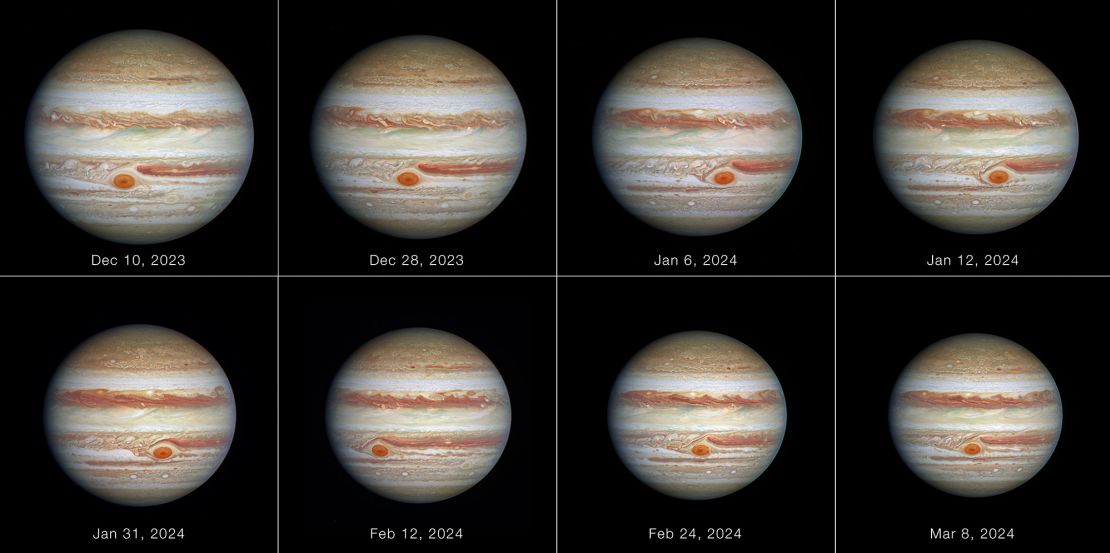Sign up for CNN’s Wonder Theory science newsletter. Explore the universe with news about fascinating discoveries, scientific breakthroughs and more.
CNN
—
New observations of Jupiter’s Great Red Spot captured by the Hubble Space Telescope show that the 190-year-old storm wiggles like gelatin and changes shape like a compressed pressure ball.
Hubble’s unexpected observations, taken over 90 days from December to March, show that the Great Red Spot is not as stable as it appears, according to astronomers.
The Great Red Spot, or GRS, is an anticyclone, or large circulation of air in Jupiter’s atmosphere, that rotates around a center of high pressure along the planet’s southern midlatitude cloud belt. And the long-term storm is so big — the largest in the Solar System — that Earth can fit inside it.
Although storms are generally considered transient, the Great Red Spot lasted nearly two centuries. But the observed changes in the storm seem to be related to its movement and size.
A time-lapse of the images shows the gelatin-like spiral “jigging” and expanding and contracting over time.
The researchers described the observation in an analysis published in The Planetary Science Journal and presented Wednesday at the 56th annual meeting Division of Planetary Sciences of the American Astronomical Society in Boise, Idaho.
“Although we knew that its motion varied slightly along its longitude, we didn’t expect an oscillation of that magnitude. As far as we know, this hasn’t been identified before,” said lead study author Amy Simon, a planetary scientist at NASA’s Goddard Space Flight Center in Greenbelt, Maryland.
“This is the first time we’ve had the exact imaging cadence of the GRS,” Simon said. “With Hubble’s high resolution, we can tell that the GRS is moving fast and slow while squeezing firmly in and out. This is very unexpected.”
Astronomers have observed the iconic crimson feature for at least 150 years, and sometimes, the observations turn up surprises, including the recent revelation that the storm’s oval shape can change dimensions and sometimes become thinner or fatter.
Recently, a separate team of astronomers peered into the heart of the Great Red Spot using the James Webb Space Telescope to capture new details in infrared light. Hubble observations were made in visible and ultraviolet light.
The study, published on September 27 Journal of Geophysical Research: PlanetsThe Great Red Spot revealed a cooling core, which condenses ammonia and water into the vortex to form dense clouds. The research team found phosphine, a gas in the storm, that could play a large role in creating “those mysterious” red colors that make the Great Red Spot so iconic, said study co-author Lee Fletcher, professor of planetary science at the University of England. Leicester, in a statement.
NASA scientists use Hubble’s sharp eye to track storm behavior once a year through the Outer Planet Atmospheres Legacy, or OPAL, project led by Simon. Scientists use this program to observe the outer planets in our solar system and see how they change over time.
But the new observations were taken separately by a project dedicated to studying the Great Red Spot in more detail, looking at how the storm changed over a few months, rather than as a yearly snapshot.
“To the untrained eye, Jupiter’s streaky clouds and famous red storms may appear stable, stable, and long-lasting over many years,” Fletcher said. “But closer inspection shows incredible variability, chaotic weather patterns as complex as anything on Earth. Planetary scientists have been trying for years to see patterns of this variability, anything that might give us a handle on the physics that underlies this complex system.
Fletcher was not involved in the new study.
Insights gathered through the project’s observations of the largest storms in our solar system could help scientists understand what the weather might be like on exoplanets orbiting other stars. That knowledge will expand their understanding of weather processes beyond what we experience on Earth.
Using Hubble’s high-resolution images, Simon’s team looked in detail at the changes in size, shape and color of the Great Red Spot.
“If we look closely, we see a lot of things are changing from day to day,” Simon said.
These changes include brightening the center of the storm as the Great Red Spot oscillates at its largest.
“As it accelerates and decelerates, the GRS pushes against its north and south wind jet streams,” Mike Wong, a planetary scientist at the University of California, Berkeley, said in a statement. “It’s like a sandwich where the pieces of bread are pushed out when there’s too much filling in the middle.”
On Neptune, dark spots can move across the planet because strong jet streams aren’t holding them back, Wong said, while the Great Red Spot is trapped between jet streams at southern latitudes on Jupiter.
Astronomers have observed the Great Red Spot shrinking since the OPAL project began a decade ago, and predict it will continue to shrink until it reaches a stable, less elongated shape, which will slow the wobble.
“Now it’s overfilled Its latitudinal band relative to the wind sector. Once it shrinks into that band, the wind actually holds it in place,” Simon said.

The new Hubble study fills in many pieces of the puzzle about the Great Red Spot, Fletcher said. Although scientists know the storm’s westward drift has an unexplained 90-day oscillation, the pattern of acceleration and deceleration does not appear to change as the storm shrinks, he said.
“By looking at the GRS over a few months, Hubble has shown that the anticyclone changes its shape with this oscillation,” Fletcher said. “The change in shape is important because it can affect how the edge of the vortex interacts with other passing storms. In addition to the beautiful Hubble images, this study shows the potential of observing atmospheric structures over long periods of time. You need that kind of observation to find these patterns, and the longer you look, the more confusing they become. Clearly you are seeing more structure in the weather.
